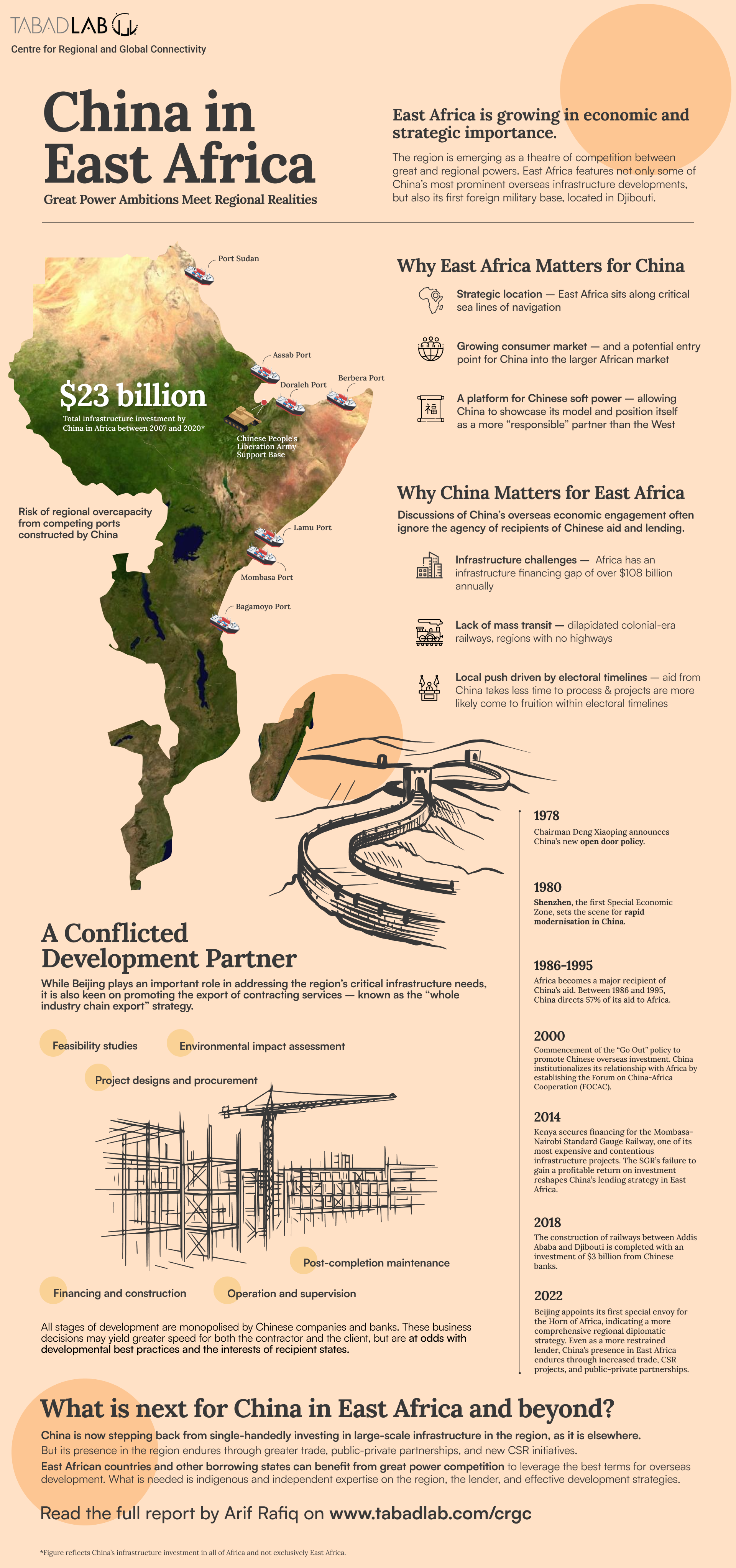Read and download the complete Working Paper here.
East Africa, particularly the Horn of Africa subregion, is growing in economic and strategic importance. The region is emerging as a theatre of competition between the great and regional powers. Unsurprisingly, East Africa features not only some of China’s most prominent overseas infrastructure developments, including the Addis Ababa-Djibouti and Mombasa-Nairobi standard gauge railways, but also its first foreign military base, located in the tiny country of Djibouti.
This competitive environment, along with the region’s rapidly growing population and enduring socio-political challenges, make East Africa a compelling study of China’s global engagement.
The region manifests a wide range of potential development outcomes and presents a test for China’s ambitions as a global power and its “Going Out” or zou chuqu policy. East Africa is home to several frontier markets — including Ethiopia, Kenya, and Tanzania — that have tremendous upsides, driven in part by rapidly-growing, young populations. At the same time, they remain mired in inter-ethnic, inter-tribal, or centre-periphery disputes, as the ongoing conflict between the Ethiopian government and the Tigray People’s Liberation Front (TPLF) demonstrates. These internal cleavages are often cross-border or leveraged and manipulated by outside powers. Along with persistent governance and human development challenges, these divisions serve as barriers to sustained, equitable economic growth.
Fusing primary and secondary sources, including interviews with local and foreign experts as well as practitioners, this report assesses the following questions:
• What are local perceptions of China as a development partner and strategic actor and its rise in the region, especially in comparison to other established powers?
• How effective and adaptable is China as a development partner and strategic actor?
• To what extent is Beijing “learning by doing?”
China has a long history in East Africa. And its importance in the region continues to grow. This is said to be spurred in part by the Belt and Road Initiative (BRI) — the latest and most ambitious iteration of China’s “Going Out” policy. Initial discussions of the Belt and Road in East Africa centred on Beijing’s potential to transform the region’s economic geography. But that is proving to be easier said than done.
China is now stepping back from large-scale infrastructure investment in the region and on the broader continent — as it is elsewhere. An ‘exuberant’ wave of overseas development financing by Beijing has since tempered, after first surging from just under USD 10 billion in 2008 to over USD 70 billion in 2016, and then falling to just around USD 10 billion in 2018. Beijing is a more restrained lender, having refused to finance the extension of Kenya’s Standard Gauge Railway to Uganda and Ethiopia’s standard gauge Weldiya-Mekele rail line. As the most recent Forum on China-Africa Cooperation (FOCAC) summit indicates, Beijing is dialling down infrastructure lending in Africa as a whole, placing a greater emphasis on providing more access to imports from Africa. It is also disbursing loans through African policy banks rather than directly, reducing its political exposure.
These and other changes indicate that China is an adaptable development partner and that it is, to some degree, capable of self-correction and responsive to the needs of recipient states. But China has yet to demonstrate that, compared to other major development financiers, it is able to produce substantially better outputs and transformative change in East Africa. In fact, China’s role as a development partner is complicated by its additional role as an exporter of contracting services. These roles are, at the same time, complementary and contradictory. The push to “go out” and export its overcapacity and oversupply — also known as the “whole industry chain export” or “export-supply chain” strategy — positions China as uniquely efficient in infrastructure construction. But the unrestrained push to build has also created an overcapacity in recipient states in the short to-medium period, with projects risking becoming “white elephants” in the longer term.
It is vital for East African states to develop indigenous institutional resources to assess project viability, develop master infrastructure plans, coordinate with neighbours on projects that have regional ambitions, and understand China. While Chinese influence in the region will endure, despite the decline in development financing, neither China nor the so-called China model have proved to be transformational in East Africa. It is in the interest of regional states to maintain broad foreign partnerships and forge their own path forward.
Read and download the complete Working Paper here.
A Non-Resident Fellow at the Middle East Institute in Washington, DC and president of Vizier Consulting, LLC, a political risk advisory firm focused on the Middle East and South Asia.






